| Megachile | |
|---|---|
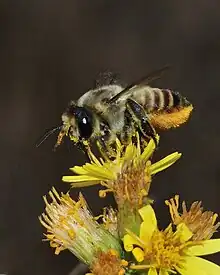 | |
| Megachile lagopoda | |
| Scientific classification | |
| Domain: | Eukaryota |
| Kingdom: | Animalia |
| Phylum: | Arthropoda |
| Class: | Insecta |
| Order: | Hymenoptera |
| Family: | Megachilidae |
| Genus: | Megachile Latreille, 1802 |
| Subgenera | |
|
Over 50 subgenera and 1520 spp., see list | |
| Synonyms | |
| |
_-_Keila.jpg.webp)
The genus Megachile is a cosmopolitan group of solitary bees, often called leafcutter bees or leafcutting bees; it also includes the called resin bees and mortar bees. While other genera within the family Megachilidae may chew leaves or petals into fragments to build their nests, certain species within Megachile neatly cut pieces of leaves or petals, hence their common name. This is one of the largest genera of bees, with more than 1500 species[1] in over 50 subgenera.[2] The alfalfa leafcutter bee (Megachile rotundata) is managed on a commercial scale for crop pollination, and has been introduced by humans to various regions around the world.
Ecology
Nests are sometimes constructed within hollow twigs or other similarly constricted natural cavities, but often are in burrows in the ground. Nests are typically composed of single long columns of cells, the cells being sequentially constructed from the deepest portion of the tunnel outwards. The female places an egg in each cell with a supply of food, generally pollen, sometimes mixed with nectar. She builds a cap and walls off the cell. The larva hatches from the egg and consumes the food supply. After moulting a few times, it spins a cocoon and pupates, often after several months of hibernation as a prepupa. It emerges from the nest as an adult. Males, which are typically smaller and emerge in advance of females, die shortly after mating, but females survive for another few weeks, during which time they build new nests. Numerous families of wasps and bees parasitize Megachile nests, including Gasteruptiidae, Leucospidae, Sapygidae, and various kleptoparasitic megachilids, such as the closely related genus Coelioxys. M. rotundata and M. campanulae are among of the first insects documented in scientific literature to use synthetic materials for making nests.[3]
Many Megachile species use cut leaves to line the cells of their nests. It is thought that the leaf discs help prevent the desiccation of the larva's food supply.[1] Various species in the genus, especially those in the subgenus Chalicodoma and related groups, do not use cut leaves to line the cells, but instead use fairly dry plant resin, which they carry in their mandibles. The subgenus Chalicodoma includes the world's largest bee, Megachile pluto, as well as one of the largest megachilids in the United States, the recently introduced Asian species, Megachile sculpturalis.
Some Megachile species have no lobe (arolia) between their claws, thus are unable to climb smooth walls or glass.[4]
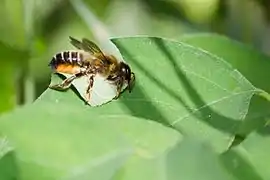 Megachile centuncularis cutting a leaf
Megachile centuncularis cutting a leaf Megachile sp. with cut leaf
Megachile sp. with cut leaf Leaves cut by Megachile sp.
Leaves cut by Megachile sp. Dissected nest of a Megachile bee
Dissected nest of a Megachile bee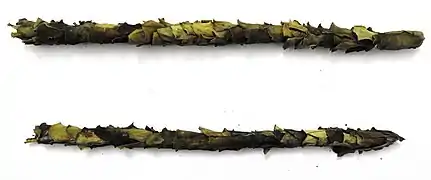 Nests of Megachile bees from Bangalore, India.
Nests of Megachile bees from Bangalore, India.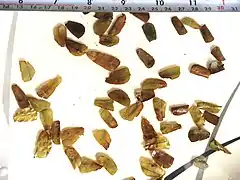 Dissected cut leaf bits from a nest.
Dissected cut leaf bits from a nest.
Diversity
The genus Megachile contains 56 subgenera with 1520 recognized species.[1] See also the list of Megachile species.
Notable subgenera:
Notable species:
- Megachile albisecta (Klug, 1817)
- Megachile campanulae, bellflower resin bee
- Megachile fidelis, faithful leafcutting bee
- Megachile perihirta, western leafcutting bee
- Megachile pluto, the largest bee in the world
- Megachile rotundata, alfalfa leafcutter bee
- Megachile rubi
- Megachile sculpturalis, giant resin bee
- Megachile texana, Texas leafcutter bee
Gallery
_from_Badlands_National_Park%252C_South_Dakota_-_USGS_Bee_Inventory_and_Monitoring_Laboratory.jpg.webp)

 Male Megachile Subgenus Xanthosarus with modified front legs
Male Megachile Subgenus Xanthosarus with modified front legs Shelter built for Megachile
Shelter built for Megachile Leafcutter bee life cycle
Leafcutter bee life cycle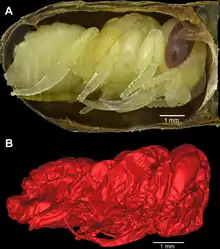 Comparison between a modern pupa and a fossil pupa from the La Brea Tar Pits
Comparison between a modern pupa and a fossil pupa from the La Brea Tar Pits Megachile inimica female
Megachile inimica female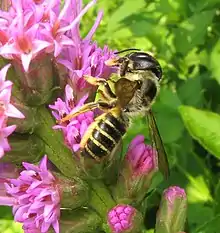 Megachile pugnata pugnata female
Megachile pugnata pugnata female
References
- 1 2 3 Wedmann, Sonja; Wappler, Torsten; Engel, Michael S. (2009). "Direct and indirect fossil records of megachilid bees from the Paleogene of Central Europe (Hymenoptera: Megachilidae)". Naturwissenschaften. 96 (6): 703–712. Bibcode:2009NW.....96..703W. doi:10.1007/s00114-009-0525-x. PMID 19296064.
- ↑ Michener, Charles Duncan (2000). The Bees of the World. Baltimore: JHU Press. p. 556.
- ↑ MacIvor, J Scott; Moore, Andrew E. (31 December 2013). "Bees collect polyurethane and polyethylene plastics as novel nest materials". Ecosphere. 4 (12): art155. doi:10.1890/ES13-00308.1. hdl:10315/27013.
- ↑ Baker, Donald B.; Engel, Michael S. A new subgenus of Megachile from Borneo with arolia (Hymenoptera, Megachilidae). American Museum novitates ; no. 3505
- Baker, D.B. & M.S. Engel, 2006: A New Subgenus of Megachile from Borneo with Arolia (Hymenoptera: Megachilidae). American Museum Novitates 3505 : 1–12. doi:10.1206/0003-0082(2006)505[0001:ANSOMF2.0.CO;2]. Full article: .
- Durante, S. ; A.H. Abrahamovich & M. Lucia, 2006: The subgenus Megachile (Dasymegachile) Mitchell with special reference to the Argentine species (Hymenoptera: Megachilidae). Neotropical Entomology 35 (6): 791–802. Abstract and full article: doi:10.1590/S1519-566X2006000600012.
- Durante, S.; Cabrera, N. 2009: Cladistic analysis of Megachile (Chrysosarus) Mitchell and revalidation of Megachile (Dactylomegachile) Mitchell (Hymenoptera, Megachilidae). Zootaxa, 2284: 48–62. Abstract & excerpt
- Engel, M.S., 2008: A new species of Megachile (Eutricharaea) from western Saudi Arabia related to Megachile walkeri (Hymenoptera: Megachilidae). Acta Entomologica Slovenica 16(2).
- Niu, Z.-Q.; Wu, Y.-R.; Zhu, C.-D., 2012: A review of Megachile (Chelostomoda) Michener (Megachilidae: Megachilini) known from China with the description of a new species. Zootaxa, 3267: 55–64. Preview
- Wu, Y.-R., 2005: A study on the genus Megachile Latreille from China with descriptions of fourteen new species (Apoidea: Megachilidae). Acta Zootaxonomica Sinica 30 (1): 155–165.
External links
- Megachile Identification Guide (female) discoverlife.org
- Megachile Identification Guide (male) discoverlife.org
- List of Species discoverlife.org
- Worldwide Species Map discoverlife.org